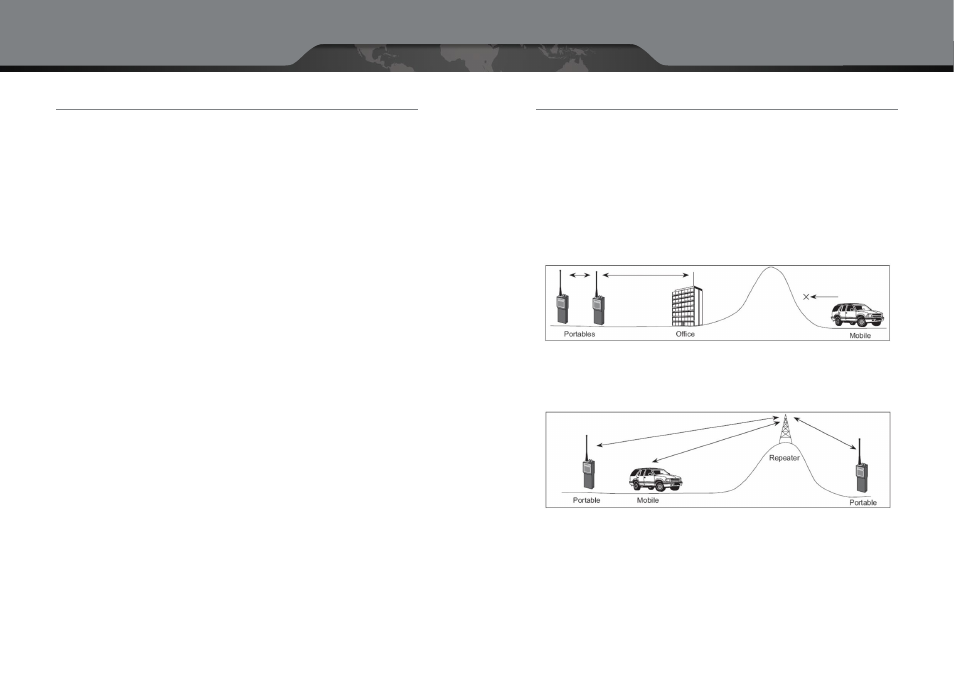5 typical applications, 6 benefits – Codan Radio Transportable Radio Systems User Guide User Manual
Page 4

www.codanradio.com
© Copyright 2015
© Copyright 2015
www.codanradio.com
PAGE 7
PAGE 6
1.5 Typical Applications
Applications for Transportable Radios are as diverse as the First Responder agencies (Police, Fire, Ambulance, Search
and Rescue, Civil Defense, Forest Fire Fighters, Reconstruction and Recovery operations) using them. In fact it is hard
to imagine a First Responder group that doesn’t need a Transportable Radio System.
• Forest Fires —
Transportable Radios are deployed during Forest Fire season providing on-site communications. The
repeater may be confi gured with cross banding capabilities to facilitate communications with spotter helicopters
or water bombers fi ghting the fi res.
• Natural Disasters —
Hurricanes, earthquakes and tsunamis can destroy fi xed infrastructure (as was the case with
Hurricane Katrina in New Orleans), Transportable Radio Systems provide temporary communications to on-site fi rst
responders and also provide additional communications infrastructure for fi rst responders that may be coming into
the region to assist.
• Multiagency Tactical response —
require tactical or covert communications with encryption. Radio equipment
packaged in a compact, low visibility black suitcase will not be obvious to the public or allude to the nature of the
equipment being used.
• Search and Rescue —
Search and Rescue applications need communications that may not normally be served by
the existing fi xed infrastructure. A Transportable Radio provides localized communications in a collapsed building
recovery zone, tunnel or a rural region. Optional Satellite or radio links may be used to link back to an existing network.
1.6 Benefits
Transportable Radios provide instant communications anywhere, anytime. Able to be set up in a matter of minutes,
they provide fi rst responder agencies with an instant solution to communications challenges. Key benefi ts include:
•
Consumes minimal power allowing operation from solar panels or batteries
•
Intended for all weather and operational conditions (including high altitudes)
•
Capable of operation in any frequency bands
•
Supports cross banding between frequencies
•
Compact and easy to deploy by a single person
•
Analog or Digital P25 (Clear or Secure)
•
Waterproof, Shockproof, Vibration proof
•
Rapidly deployable
•
Reliable
2. Section 2 — Repeater Basics
2.1 What is a repeater?
Radio signals operate over line-of-sight paths. This implies that you must be able to see the radio with which you
wish to communicate. Actually, contact between radios slightly beyond line-of- sight distances is often possible,
owing to refl ection or refraction of the radio waves. Physical restrictions of signal paths between radio users (such
as mountains or buildings) can disrupt system operation.
The diagram below on the left shows the line-of-sight signal paths between the portables and from the portables
to the base station at the offi ce. At the far right, note the blocked signal path between the mobile and the offi ce
caused by the hill which prevents the mobile from communicating.
To extend coverage, a radio repeater is required. A repeater is nothing more than a radio or combination of radios
connected in such a way that it simply passes on or “repeats” anything that it hears. In the diagram below the re-
peater enables all radios to communicate together.
Limited communication due to obstructions
Repeater installed to enable communications